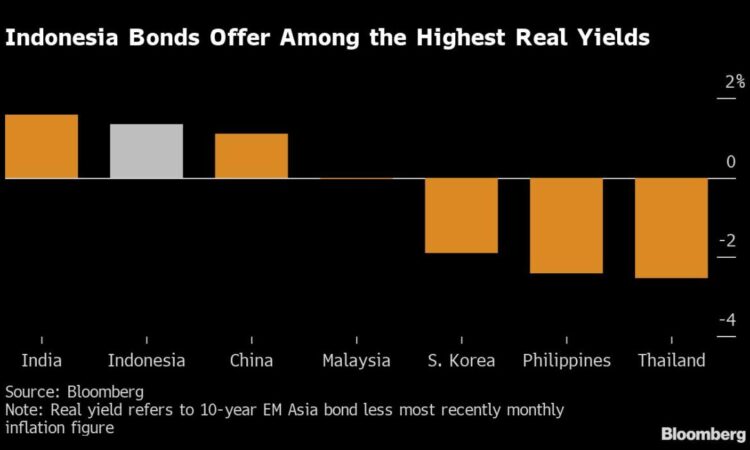
(Bloomberg) — The Indonesian rupiah is off to a roaring start at the beginning of the year thanks to the currency’s appealing carry returns, and analysts are betting it may end 2023 with the biggest annual gain in more than a decade.
Most Read from Bloomberg
The currency has climbed about 3% this year in Asia’s best performance to 15,134 a dollar on Friday, and may further rise to 14,200 by year-end as foreigners raise holdings of local debt which offers one of the highest yields in the region, according to strategists at Maybank and Jefferies LLC. That would extend the year’s rally to about 9%, its biggest annual gain since 2009.
“We see very little reason why it would not continue given the carry, the leverage to commodities and not to mention a pragmatic central bank,” said Brad Bechtel, a New York-based currency strategist at Jefferies, who expects the rupiah to trade at 14,250 in six-to-twelve months.
“We may have a broader US dollar correction higher in the near term, but that would be a great sell opportunity for dollar-rupiah, especially if we get back into the 15,300 area.”
Here are charts showing the state of play in the rupiah market:
The rupiah delivered the best carry returns in Asia this year when funded through the dollar, euro and Japanese yen, according to Bloomberg-compiled data. The carry trade should continue given Indonesian local-currency bonds will be favored, said Galvin Chia, a strategist at Natwest Markets in Singapore. “It has got lower correlation to the US dollar than some of its peers like the won, the Singapore dollar and the baht,” he said.
Foreign investors returned to Indonesia’s bond market late last year after shunning the country for most of 2022, and there’s scope for more buying. While offshore funds bought a record $3.3 billion last month, they remain underweight Indonesian debt, holding just 15% of total outstanding issuance, well below the pre-pandemic levels.
Indonesia’s 10-year bonds offering one of the highest yields in the region is another lure for overseas investors. The note offers a real yield of about 1.3% amid easing price pressures. The nation’s central bank expects inflation to continue easing and return toward its 2%-4% target by the second half of the year, and has signaled an end to monetary tightening.
The nation’s trade surplus is among the highest in Asia, helped by booming commodity exports including palm oil and nickel. While it’s expected to ease this year, the government’s forecast of a $38.5 billion surplus for this year is still higher than 2021, and may help support the rupiah.
The rupiah has rallied as foreign investors flocked back to its bond market to pare almost half of its losses over the past two years. Along with a weakening dollar, continued bond inflows will extend the rally, said Alan Lau, a strategist at Maybank.
–With assistance from Marcus Wong and Grace Sihombing.
Most Read from Bloomberg Businessweek
©2023 Bloomberg L.P.






